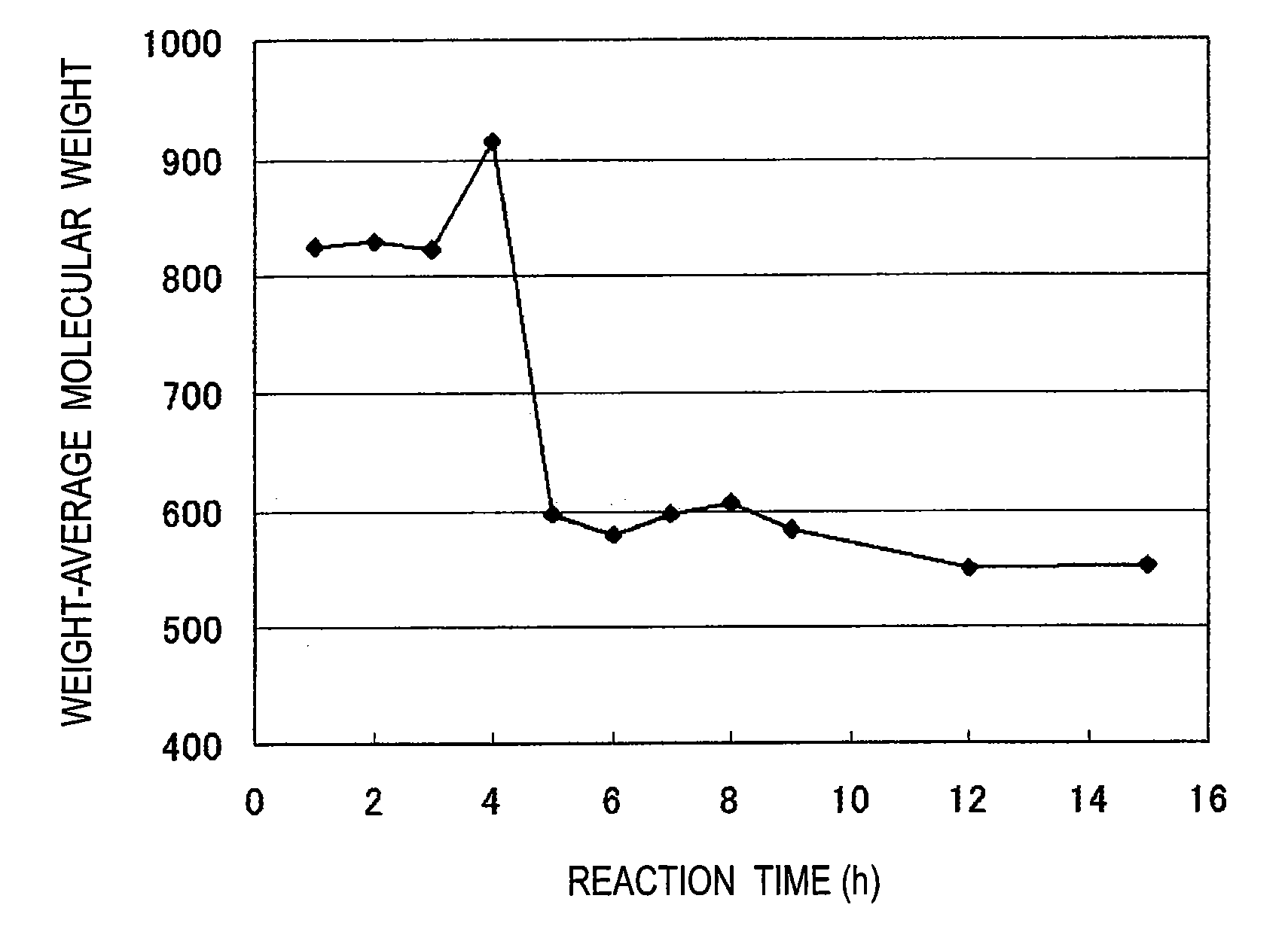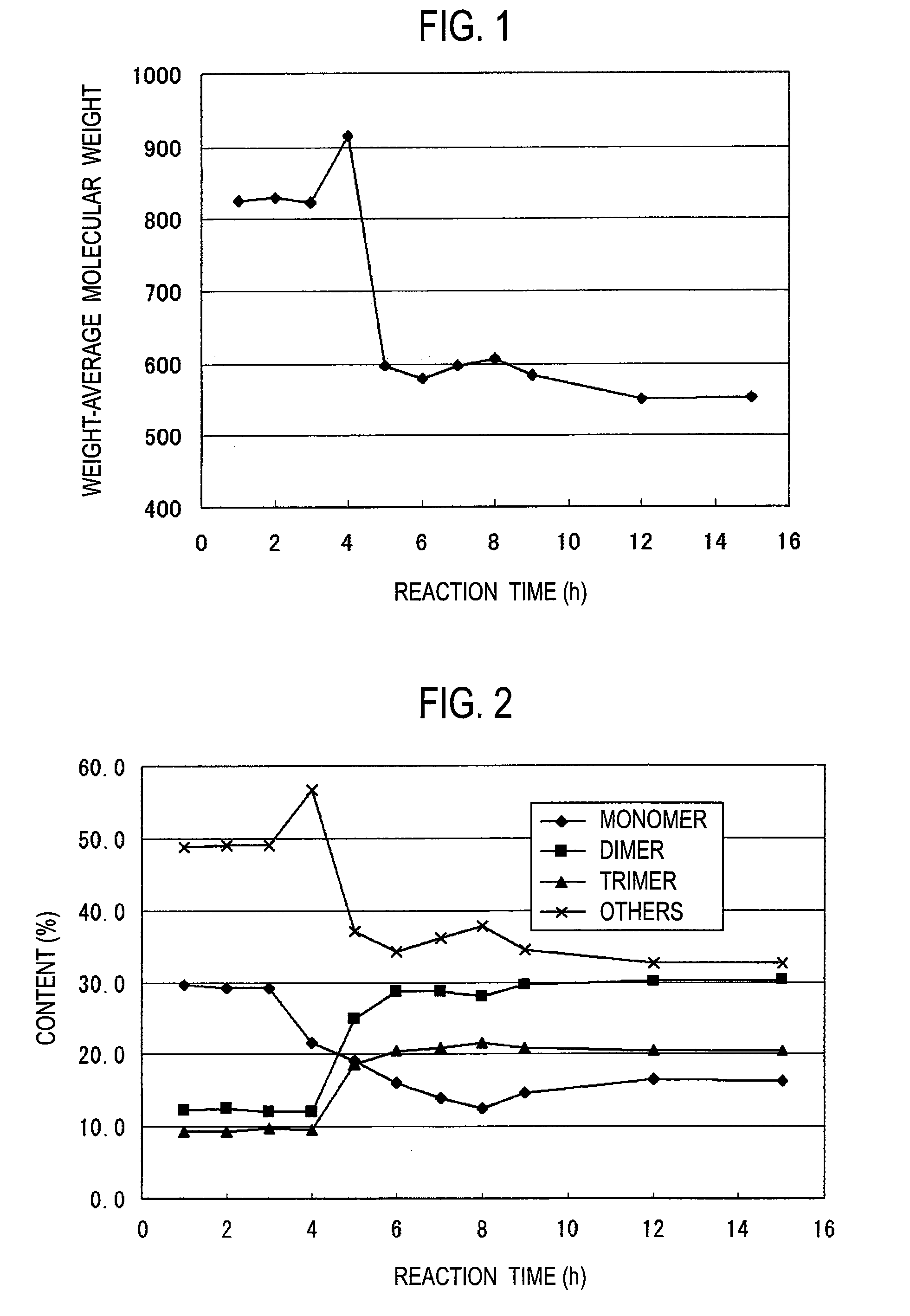Phenol resin and resin composition
a technology which is applied in the field of phenol resin and resin composition, can solve the problems that the benzoxanthene derivative formed by using this synthesis process cannot form a hydroxyl group useful for chemical modification and for reaction with epoxy resin
- Summary
- Abstract
- Description
- Claims
- Application Information
AI Technical Summary
Benefits of technology
Problems solved by technology
Method used
Image
Examples
example 1
[0050]A 2-L separable flask equipped with a stirrer, a condenser and a thermometer was charged with 220 g of catechol, 81.1 g of 37% formalin, 2.5 g of oxalic acid and 100 g of water, and the mixture was heated on an oil bath to 100° C. The reaction was continued for 3 hours at about 104° C. under reflux.
[0051]Thereafter, the temperature in the flask was increased to 150° C. while water was distilled away. The reaction was continued for 12 hours at a temperature kept at 150° C. Thereafter, the reaction solution was concentrated for 20 minutes under reduced pressure to remove the water etc. in the system, thereby recovering the resulting phenol resin. The resulting resin had a number-average molecular weight of 400 and a weight-average molecular weight of 550. The hydroxyl equivalent of the resin was confirmed to be 112 by titration as described later. The change in the weight-average molecular weight during synthesis is shown in FIG. 1, and the change in the contents (number of nucl...
example 2
[0056]A 2-L separable flask equipped with a stirrer, a condenser and a thermometer was charged with 220 g of catechol, 97.3 g of 37% formalin, 5 g of oxalic acid and 200 g of water, and the mixture was heated on an oil bath to 100° C. The mixture was refluxed at about 104° C., and the reaction was continued at the reflux temperature for 3 hours. Thereafter, the temperature in the flask was increased to 140° C. while water was distilled away. The reaction was continued for 12 hours at a temperature kept at 140° C. Thereafter, the reaction solution was heated to 160° C. and concentrated for 20 minutes under reduced pressure to remove the water etc. in the system, thereby recovering the resulting phenol resin. The resulting resin had a number-average molecular weight of 500 and a weight-average molecular weight of 700. The hydroxyl equivalent of the resin was 118. The change in the weight-average molecular weight during synthesis is shown in FIG. 4, and the change in the contents of a ...
example 3
[0058]A 3-L separable flask equipped with a stirrer, a condenser and a thermometer was charged with 462 g of resorcinol, 198 g of catechol, 316.2 g of 37% formalin, 15 g of oxalic acid and 300 g of water, and the mixture was heated on an oil bath to 100° C. The mixture was refluxed at about 104° C., and the reaction was continued for 4 hours at the reflux temperature. Thereafter, the temperature in the flask was increased to 170° C. while water was distilled away. The reaction was continued for 8 hours at a temperature kept at 170° C. Thereafter, the reaction solution was concentrated for 20 minutes under reduced pressure to remove the water etc. in the system, thereby recovering the resulting phenol resin. The resulting resin had a number-average molecular weight of 540 and a weight-average molecular weight of 1000. The hydroxyl equivalent of the resin was 108. The change in the weight-average molecular weight during synthesis is shown in FIG. 7, and the change in the contents of a...
PUM
| Property | Measurement | Unit |
|---|---|---|
| softening point | aaaaa | aaaaa |
| mol % | aaaaa | aaaaa |
| temperature | aaaaa | aaaaa |
Abstract
Description
Claims
Application Information
 Login to View More
Login to View More - R&D
- Intellectual Property
- Life Sciences
- Materials
- Tech Scout
- Unparalleled Data Quality
- Higher Quality Content
- 60% Fewer Hallucinations
Browse by: Latest US Patents, China's latest patents, Technical Efficacy Thesaurus, Application Domain, Technology Topic, Popular Technical Reports.
© 2025 PatSnap. All rights reserved.Legal|Privacy policy|Modern Slavery Act Transparency Statement|Sitemap|About US| Contact US: help@patsnap.com



